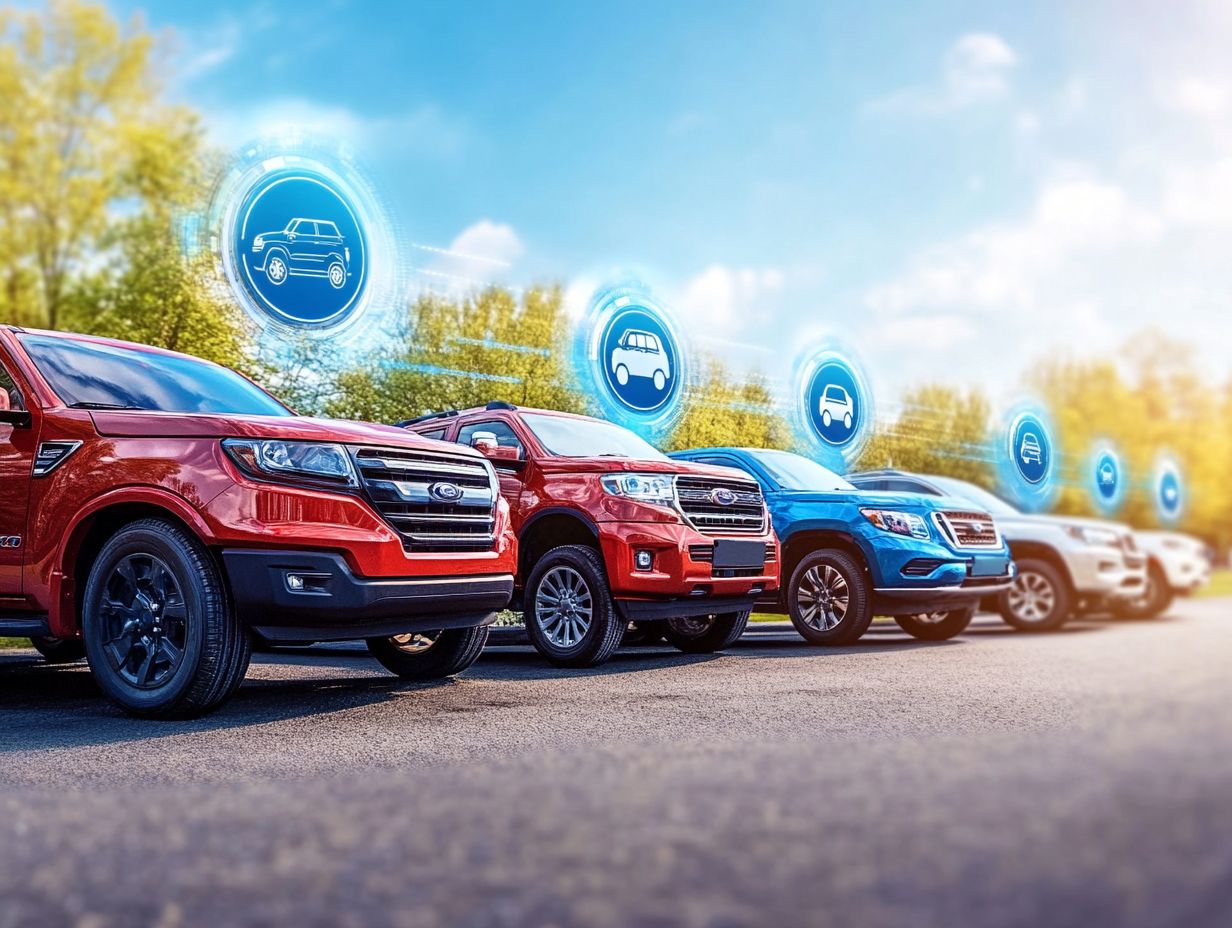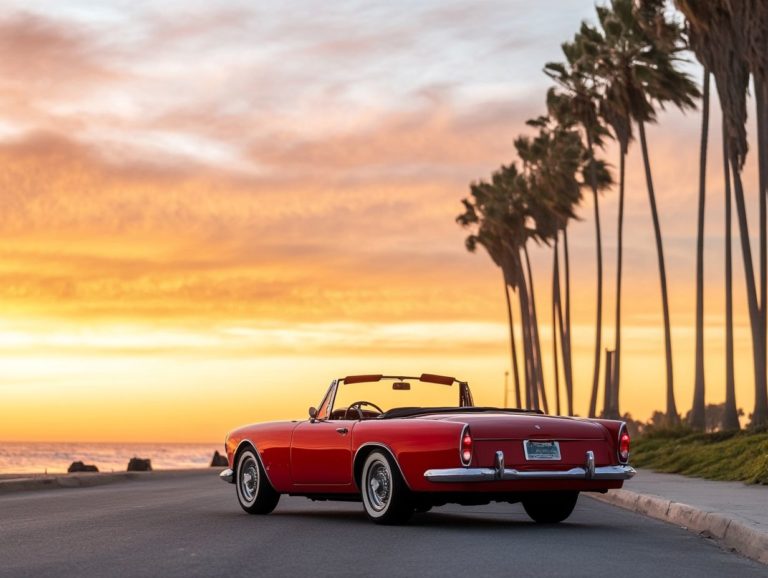How to Match Your Coverage with Your Vehicle Type
Selecting the right insurance for your vehicle can indeed feel overwhelming, given the many options at your disposal.
Consider that different vehicle types, whether it s a sedan or an SUV, come with their own specific insurance needs. These factors influence your coverage decisions.
This article delves into the various vehicle types, examines common insurance coverage options, and provides insightful tips on how to align your coverage with your specific vehicle and driving habits.
You ll also find practical strategies designed to help you save on premiums without compromising on the protection you require. Don t miss out on great savings!
Contents
- Key Takeaways:
- Understanding Vehicle Types
- Types of Insurance Coverage
- Factors to Consider When Matching Coverage with Vehicle Type
- How to Choose the Right Coverage for Your Vehicle Type
- Tips for Saving on Insurance Costs
- Frequently Asked Questions
- What does it mean to match your coverage with your vehicle type?
- Why is it important to match your coverage with your vehicle type?
- How can I determine the right coverage for my vehicle type?
- What factors should I consider when matching coverage with my vehicle type?
- Do I need different coverage for different types of vehicles I own?
- Can I change my coverage if I switch to a different vehicle type?
Key Takeaways:

- Know your vehicle type – different types serve different purposes and require different coverage.
- Consider vehicle age and usage when selecting coverage – these factors can affect the level of coverage needed.
- Evaluate your needs and budget to find the right coverage for your vehicle type, and look for ways to save on insurance costs through discounts and strategies.
Understanding Vehicle Types
Understanding the various types of vehicles is essential when navigating your auto insurance options. Each vehicle whether it s a car, motorcycle, ATV, or recreational vehicle (RV) comes with its own set of characteristics that will influence your insurance requirements and coverage selections.
Each type presents unique risk factors. It is imperative for you to assess your specific needs and preferences before settling on an insurance policy.
In areas like New Hampshire and Virginia, the type of vehicle can also affect the local insurance market landscape, shaping the offerings from different insurance providers.
Different Types of Vehicles and Their Uses
Different types of vehicles serve a multitude of purposes, which directly influences how you should approach their insurance and the coverage options available to you.
For instance, cars are primarily your go-to for daily commutes and family outings. You will want comprehensive auto insurance, which means it covers damages to your car, injuries to others, and your own medical costs.
On the flip side, if you re drawn to the thrill of motorcycles, be aware that while they offer an exhilarating ride, they also come with higher risk factors due to exposure and limited visibility. Specialized coverage is essential, addressing both injury protection and liability. Here are some key needs for motorcycle insurance:
- Higher risk factors due to exposure
- Specialized coverage needed for injury protection
Then there are All-Terrain Vehicles (ATVs), often your choice for recreation in rugged terrains. Their insurance needs are distinct, requiring off-road coverage with specific usage limits to suit your adventurous spirit.
Recreational vehicles, such as campers and trailers, present unique challenges in the insurance landscape. Since these are sometimes used seasonally or for extended road trips, insurers take into account factors like mileage, storage, and even the amenities you have on board.
Understanding the specific needs tied to each vehicle type is vital for ensuring you have adequate coverage while remaining compliant with legal requirements. For tailored advice, refer to this guide on how to select coverage based on your situation.
Types of Insurance Coverage
When looking into auto insurance, it’s crucial for you to grasp the different types of coverage options available. From liability insurance to medical payments, personal injury protection, uninsured motorist coverage, collision coverage, and comprehensive insurance, each plays a vital role in providing you with the financial protection you need against the risks that come with owning and operating a vehicle.
Understanding these options gives you the power to make informed decisions that safeguard your interests. What type of coverage do you think your vehicle needs? Let s find out together!
Overview of Common Coverage Options

Auto insurance offers essential financial protection. It includes liability insurance, collision coverage, and comprehensive insurance.
These options work together to shield you from high financial costs due to unexpected events. Liability insurance is crucial. It covers expenses from injuries or damages you cause in an accident.
Collision coverage helps pay for repairs to your vehicle after an accident, regardless of fault. This way, you can get your car back on the road without financial strain.
Comprehensive insurance protects against non-collision events like theft and natural disasters. This coverage ensures you’re prepared for various risks.
Having a well-rounded policy is essential for protecting your finances.
Factors to Consider When Matching Coverage with Vehicle Type
When aligning insurance coverage with your vehicle type, consider key factors. Understanding how to navigate coverage for seasonal vehicles is essential, as the age and value of your vehicle greatly influence your insurance needs.
Understanding these factors allows you to make informed choices and select policies that provide the right protection. This also helps you avoid overspending on premiums.
Vehicle Age and Value
The age and value of your vehicle are important for determining your insurance premiums. They guide you toward the best policy for your financial protection.
As your vehicle ages, its market value usually decreases. This often leads to lower insurance premiums, allowing you to consider options like liability-only policies.
Keep in mind that older cars might miss out on perks like roadside assistance or rental reimbursement. Knowing this helps you tailor your insurance to meet both coverage goals and budget needs.
Driving Habits and Usage
Your driving habits significantly impact your insurance risks. They directly affect the types of coverage you need.
If you often commute long distances, you face a higher accident risk due to more time on the road. Insurance companies may review your profile accordingly.
Frequent travel for work or leisure may prompt insurers to focus on your driving history and your vehicle’s safety features. These factors can influence your premiums.
The more mileage you put on your vehicle, the higher your risk. Understanding these aspects empowers you to make better insurance choices.
How to Choose the Right Coverage for Your Vehicle Type

Choosing the right coverage requires a thorough assessment of your insurance needs and budget. Understand the policy limits and explore available options.
Evaluate these factors carefully to ensure you secure the best protection tailored to your situation.
Evaluating Your Needs and Budget
Evaluating your insurance needs and budget is a pivotal step in selecting the right auto insurance coverage. This ensures alignment with your financial circumstances while providing the protection you deserve.
Understanding the specifics of your vehicle whether it s a compact car, an SUV, or a luxury model is significant in determining your coverage requirements and the potential risks involved.
Think about how often you use your vehicle, whether for daily commutes, weekend getaways, or business trips. This information will further refine your insurance needs.
It’s crucial to establish a realistic budget that balances premium costs with potential out-of-pocket expenses when claims arise. You can effectively compare insurance premiums and options from various providers using online comparison tools.
This approach ensures valuable insights into a spectrum of offerings while considering factors like deductibles (the amount you pay out of pocket before insurance kicks in), coverage limits, and customer satisfaction ratings.
Tips for Saving on Insurance Costs
You can save on insurance costs by employing a range of strategies. Consider taking advantage of available discounts and comparing quotes from different providers.
Optimizing your coverage ensures it aligns perfectly with your financial goals.
Discounts and Strategies for Lower Premiums
By utilizing various insurance discounts and adopting effective strategies, you can significantly lower your premiums. This ensures essential financial protection without sacrificing coverage quality.
Consider exploring options like safe driver discounts for maintaining a clean driving record, multi-policy discounts that bundle your home and auto insurance, and loyalty rewards for being a long-term customer.
These strategies can help you maximize your savings! Engaging proactively with your insurance providers enhances your overall experience and opens the door to tailored advice and assistance.
You might even uncover additional discounts that aren t widely advertised. This proactive communication can lead to better rates, giving you peace of mind in your coverage while also benefiting your wallet.
Frequently Asked Questions

What does it mean to match your coverage with your vehicle type?
Matching your coverage with your vehicle type means selecting insurance that is specifically tailored to your vehicle. This takes into account its unique characteristics and potential risks.
Why is it important to match your coverage with your vehicle type?
Matching your coverage ensures adequate protection in case of accidents or damage. Different vehicles have different risks, and understanding coverage for specialty vehicles can save you from potential financial losses.
How can I determine the right coverage for my vehicle type?
The best way to determine the right coverage is to consult with your insurance provider. They will assess your vehicle and its risks to help you select appropriate coverage that meets your needs and budget.
What factors should I consider when matching coverage with my vehicle type?
When matching coverage, consider the make and model of your vehicle, its age and condition, your driving habits and history, and for those with unique needs, understanding coverage for non-standard vehicles as well as your state’s minimum insurance requirements.
Do I need different coverage for different types of vehicles I own?
Yes, it’s recommended to have different coverage for different types of vehicles. For example, a sports car may require more coverage than a family minivan due to its higher value and increased risk of accidents.
Can I change my coverage if I switch to a different vehicle type?
Absolutely! You can change your coverage if you switch vehicles. Don’t delay! Regularly review and update your coverage to ensure it aligns with your current vehicle and needs. Consult with your insurance provider to make any necessary changes.
Ready to explore your options? Contact your insurance provider today for personalized quotes!






